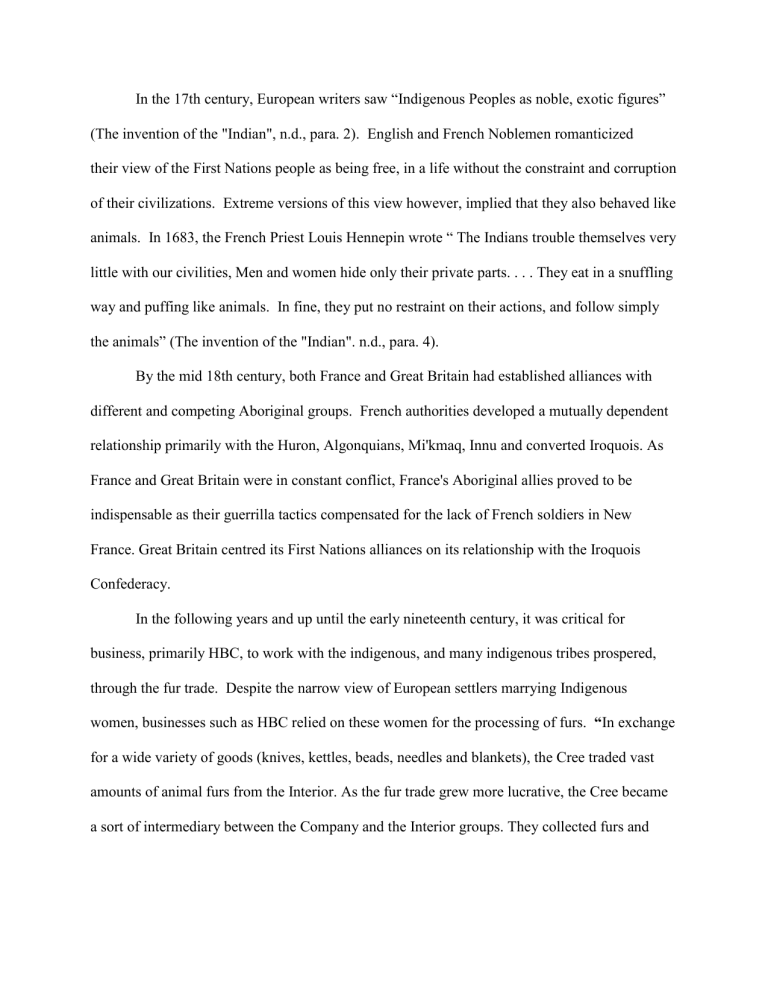
In the 17th century, European writers saw “Indigenous Peoples as noble, exotic figures” (The invention of the "Indian", n.d., para. 2). English and French Noblemen romanticized their view of the First Nations people as being free, in a life without the constraint and corruption of their civilizations. Extreme versions of this view however, implied that they also behaved like animals. In 1683, the French Priest Louis Hennepin wrote “ The Indians trouble themselves very little with our civilities, Men and women hide only their private parts. . . . They eat in a snuffling way and puffing like animals. In fine, they put no restraint on their actions, and follow simply the animals” (The invention of the "Indian". n.d., para. 4). By the mid 18th century, both France and Great Britain had established alliances with different and competing Aboriginal groups. French authorities developed a mutually dependent relationship primarily with the Huron, Algonquians, Mi'kmaq, Innu and converted Iroquois. As France and Great Britain were in constant conflict, France's Aboriginal allies proved to be indispensable as their guerrilla tactics compensated for the lack of French soldiers in New France. Great Britain centred its First Nations alliances on its relationship with the Iroquois Confederacy. In the following years and up until the early nineteenth century, it was critical for business, primarily HBC, to work with the indigenous, and many indigenous tribes prospered, through the fur trade. Despite the narrow view of European settlers marrying Indigenous women, businesses such as HBC relied on these women for the processing of furs. “In exchange for a wide variety of goods (knives, kettles, beads, needles and blankets), the Cree traded vast amounts of animal furs from the Interior. As the fur trade grew more lucrative, the Cree became a sort of intermediary between the Company and the Interior groups. They collected furs and pelts from other First Nations hunters and took them to the HBC posts on the coast” ("First Nations in Canada," 05/02/2017, para. 59). Indian Tribes were self-sufficient during this time as well. John S. Milloy, a prominent residential schools historian writes “In the period in which the British imperial government was responsible for Indian affairs from 1763 to 1860, Indian tribes were, de facto, selfgoverning.” ("Facing History and Ourselves," n.d.). This was in direct contrast to British society. Starting in the 1820s, British colonial administrators undertook many initiatives aimed at civilizing First Nations. Early assimilation tactics included encouraging an Anishinaabe group were settle in a typical colonial-style village. Here they would be instructed in agriculture and encouraged to adopt Christianity and abandon hunting and fishing as a means of subsistence. Due to poor management, underfunding and a lack of understanding of First Nations cultures and values, the project failed. (First Nations in Canada," 05/02/2017, para. 62-63). Despite initial problems, civilization of the First Nations people was one of the central tenets of Indian policy and legislation for the next 150 years. Among the first pieces of legislation passed was the Crown Lands Protection Act in 1839. This Act made the government the owner and guardian of all crown land, including Indian Reserve Lands. In response to settlement happening faster than the colony could manage, squatters were already occupying territory both on crown land and on reserves. The Act declared that the Crown was the protector of Indian Lands. It was also meant to protect Indian interests by limiting settlers’ access to reserves. In 1850, more legislation was passed, limiting trespassing and encroachment on First Nations reserve lands. This legislation also provided a definition of an "Indian", exempted First Nations from taxation and protected them from creditors ("First Nations in Canada," 05/02/2017, para. 64) In 1857, the Canadian Government passed the Gradual Enfranchisement Act. This act sought to “assimilate Indian people into Canadian settler society by encouraging enfranchisement” (Hanson, n.d., para. 6). Enfranchisement was a key feature of the governments assimilation policies. (Hanson, n.d.). This act also gave the Superintendent General of Indian Affairs a considerable amount of power over status Indians. The Superintendent could decide who was of ‘good moral character’ entitling them to benefits. He could also decide if the widow of an enfranchised Indian ‘lived respectably’ enough to keep her own children in the event of the father’s death. The Act itself restricted the governing powers of band councils, regulated alcohol consumption and sale, and determined who and who would not be eligible for band and treaty benefits(Joseph, ).



